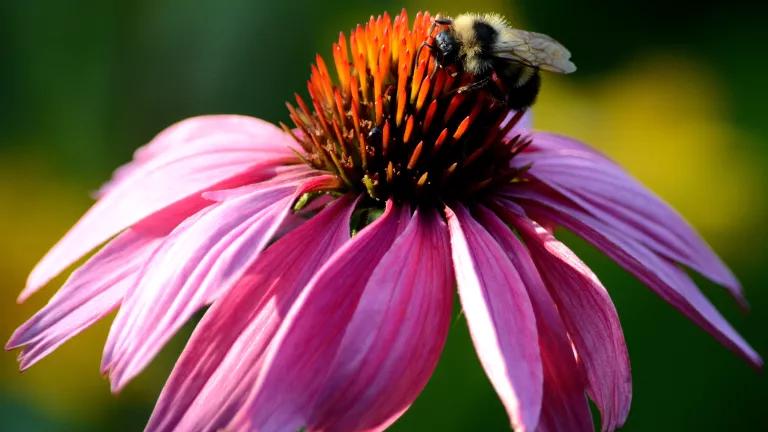Landmark Neonic Bill Headed to Governor Hochul’s Desk
The New York legislature passed a first-in-the-nation bill to dramatically curb the pesticides that decimate pollinators and threaten New Yorkers’ health.

Bees may finally get a break from toxic neonic pesticides in New York.
The New York legislature just passed the Birds and Bees Protection Act (A7640/S1856A)—a trailblazing bill from Senator Brad Hoylman and Assemblymember Deborah Glick. The bill seeks to eliminate 80-90% of neurotoxic neonicotinoid pesticides, or “neonics,” entering the state’s environment every year, which extensive Cornell University research identifies as unneeded or easily replaceable with safer alternatives.
Large loopholes in state and federal pesticide law have allowed the largest neonic uses to go largely unchecked with devastating consequences for New York’s ecosystems and public health. All eyes now turn to whether Governor Hochul will now sign the bill’s much-needed protections into law—which have the support of a broad coalition of 350+ organizations, businesses, and municipalities, farmers from across the state, brewers and other craft beverage producers, and leading health experts.
Neonics Threaten Birds, Bees, And New Yorkers Too
Neonics—the most widely used insecticides in the country—are best known for their lead role in mass losses of bees and other pollinators. These losses already limit the production of top New York crops like apples and cherries, with global fruit and vegetable production down 3-5%, harming public health by reducing food availability.
A large and growing body of evidence also shows that neonics may be the most ecologically destructive pesticides since DDT—having made U.S. agriculture 48-times more harmful to insects since their introduction. Just last month, the U.S. EPA released an unprecedented finding that use of EPA-approved neonic products likely jeopardizes the continued existence of 200+ threatened and endangered species—or ~11% of the entire endangered species list.

Neonics extensively contaminate New York water, and the bodies of New Yorkers.
The neurotoxic pesticides are also linked to:
- Mass losses of birds;
- The collapse of fisheries;
- Widespread water contamination in New York (especially on Long Island);
- Birth defects in deer; and
- Threats to New Yorker’s health, especially that of children.
The laundry list of harms comes as no surprise for those who know anything about neonics. Apart from being among the most potent insecticides ever created, neonics are also uniquely good at contaminating whole ecosystems. Designed to permeate plants—turning their nectar, pollen, and fruit toxic—neonics can be applied to a plant’s roots or as a coating on a crop seed, which the plant then absorbs as it grows. However, only 2-5% of the chemicals are typically absorbed, leaving the other 95% to persist in soil for years, where they are easily carried long distances by rain or irrigation water.
Today, neonics extensively contaminate New York’s water, soil, and plants—and even New Yorkers themselves. A recent study of over 170 pregnant women from New York and four other states found neonics in the bodies of over 95% of participants, with the highest rates in Hispanic women. Levels exceeded extensive exposures detected in earlier CDC monitoring and steadily rose over the course of the four-year study (2017-2020), echoing other research showing a recent significant spike of neonics detected in wild deer.
This widespread exposure has raised significant concerns among New York health experts. Neonics are neurotoxic and pass easily from mother to fetus—and just like lead, mercury, and other neurotoxins, there may be “no safe level” of neonic exposure, especially for children. Studies link neonic exposures in the womb with birth defects of the heart and brain, reduced cognitive abilities, and autism-like symptoms—with adult exposures linked to memory loss, muscle tremors, decreased testosterone, and lower sperm counts and motility.
The Birds and Bees Protection Act Provides Targeted, Commonsense Protections
The Birds and Bees Protection Act (A7640/S1856A) would eliminate 80-90% of the neonics entering New York’s environment by prohibiting only those neonic uses that extensive Cornell University research finds are unnecessary or easily replaced with safer alternatives.
First and foremost are neonic coatings on corn, soybean, and wheat seeds (AKA “seed treatments”)—likely the largest and most widespread use of neonics in New York, but one that Cornell finds provide “no overall net income benefit” to farmers, making them also the least justifiable use.
Due to federal and state loopholes, the state Department of Environmental Conservation (DEC) exercises no regulatory authority over treated seeds in the way it does other pesticides. That means without the Act, there are effectively no state safeguards against the largest source of neonic pollution in the state. New York would be the first state in the nation to directly regulate neonic-treated seeds, which cover hundreds of millions of acres nationwide.
The bill also prohibits “lawn and garden” neonic uses—as Nevada, New Jersey, and Maine have—except for treatments against invasive species like hemlock wooly adelgid and spotted lanternfly. These uses pose some of the highest risks to bees and are also leading sources of water contamination where many New Yorkers live, work and play (especially on Long Island). Luckily, the Cornell report finds 80% of lawns require no insecticides to control pests, and even where pests are present, less harmful and more effective alternatives are readily available.
The bill prohibits no other uses—meaning it does not affect neonic use on fruits, vegetables, and even later-season applications on corn, soybean, and wheat—making it much narrower than the total outdoor neonic ban in Europe. It is, however, well-tailored to address the heart of the neonic problem in New York by eliminating only low-to-no benefit uses. Indeed, just over the border in Quebec and Ontario, farmers have almost completely phased out neonic corn and soybean coatings without effects on yield or switching to more harmful pesticide uses.
All Eyes on Governor Hochul
While the rest of the world is already moving past neonics, full passage of the Birds and Bees Protection Act would mark a major milestone in the United States. With the bill slated to hit her desk later this year—and data showing neonic contamination and its destructive effects on bees, birds, ecosystems, and children’s health only getting worse—Governor Hochul must waste no time in signing it.



